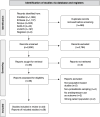Prevalence of antidepressant use in Brazil: a systematic review with meta-analysis
- PMID: 37718462
- PMCID: PMC11189131
- DOI: 10.47626/1516-4446-2023-3095
Prevalence of antidepressant use in Brazil: a systematic review with meta-analysis
Abstract
Objectives: To estimate the prevalence of antidepressant use in Brazil.
Methods: We conducted a systematic review with searches in MEDLINE, Embase, Scopus, LILACS, and SciELO up to May 2023. Two researchers independently selected studies, extracted data, and assessed the methodological quality. We pooled the prevalence of antidepressant use using meta-analyses of proportions (Freeman-Tukey transformation) and estimated heterogeneity by the I2 statistic. OR meta-analyses of antidepressant use by sex were calculated (men as reference) and between-study variation was explored by meta-regressions.
Results: Out of 3,299 records retrieved, 23 studies published in 28 reports were included, with a total of 75,061 participants. The overall prevalence of antidepressant use was 4.0% (95%CI 2.7-5.6%; /² = 98.5%). Use of antidepressants in the previous 3 days was higher in women (12.0%; 95%CI 9.5-15.1%; /² = 0%) than men (4.6%; 95%CI 3.1-6.8%; /² = 0%) (p < 0.001; OR = 2.82; 95%CI 1.72-4.62). Gender differences were particularly higher for antidepressant use in the previous year (women: 2.3%; 95%CI 1.6-3.1; /² = 37.6% vs. men: 0.5%; 95%CI 0.2-1.0%; /² = 0%, p < 0.001; OR = 4.18; 95%CI 2.10-8.30). Between-study variation in the overall prevalence of antidepressant use significantly increased with mean participant age (p = 0.035; residual /² = 0%; regression coefficient = 0.003).
Conclusion: Four out of every 100 Brazilians used antidepressants in this 3-decade assessment. Use increased with age and was more prevalent in women compared to men.
Registration number: PROSPERO CRD42022345332.
Keywords: Antidepressive agents; drug utilization; mental health; prevalence; systematic review.
Conflict of interest statement
The authors report no conflicts of interest.
Figures
Similar articles
-
Prevalence of iron deficiency anemia in Brazilian women of childbearing age: a systematic review with meta-analysis.PeerJ. 2022 Feb 17;10:e12959. doi: 10.7717/peerj.12959. eCollection 2022. PeerJ. 2022. PMID: 35194530 Free PMC article.
-
Antidepressants for treating depression in dementia.Cochrane Database Syst Rev. 2018 Aug 31;8(8):CD003944. doi: 10.1002/14651858.CD003944.pub2. Cochrane Database Syst Rev. 2018. PMID: 30168578 Free PMC article.
-
Global prevalence of antidepressant drug utilization in the community: protocol for a systematic review.BMJ Open. 2022 May 31;12(5):e062197. doi: 10.1136/bmjopen-2022-062197. BMJ Open. 2022. PMID: 35641008 Free PMC article.
-
Antidepressants for people with epilepsy and depression.Cochrane Database Syst Rev. 2021 Apr 16;4(4):CD010682. doi: 10.1002/14651858.CD010682.pub3. Cochrane Database Syst Rev. 2021. PMID: 33860531 Free PMC article.
-
Adjuvant therapy with antidepressants for the management of inflammatory bowel disease.Cochrane Database Syst Rev. 2019 Apr 12;4(4):CD012680. doi: 10.1002/14651858.CD012680.pub2. Cochrane Database Syst Rev. 2019. PMID: 30977111 Free PMC article.
Cited by
-
Psychiatric drugs dispensing trends in the affected population following Brumadinho dam failure.Front Public Health. 2025 May 16;13:1507556. doi: 10.3389/fpubh.2025.1507556. eCollection 2025. Front Public Health. 2025. PMID: 40453496 Free PMC article.
-
The use of psychiatric medications and associated factors among people receiving care at a transgender outpatient clinic in Southern Brazil, 2021-2022.Epidemiol Serv Saude. 2024 Dec 6;33(spe1):e2024170. doi: 10.1590/S2237-96222024v33e2024170.especial.en. eCollection 2024. Epidemiol Serv Saude. 2024. PMID: 39661780 Free PMC article.
-
Uncovering antidepressant prescription patterns: a three-year analysis of outpatient trends.BMC Psychiatry. 2025 Feb 3;25(1):90. doi: 10.1186/s12888-025-06521-z. BMC Psychiatry. 2025. PMID: 39901169 Free PMC article.
References
-
- Lopes CS. How is Brazilian’s mental health? The importance of birth cohorts for better understanding the problem. Cad Saude Publica. 2020;36:e00005020. - PubMed
-
- Tiguman GMB, Silva MT, Galvao TF. Prevalence of depressive and anxiety symptoms and their relationship with life-threatening events, tobacco dependence and hazardous alcohol drinking: a population-based study in the Brazilian Amazon. J Affect Disord. 2022;298:224–31. - PubMed
Publication types
MeSH terms
Substances
LinkOut - more resources
Full Text Sources
Medical



